Affiliate Disclosure: By clicking through the links on this page and purchasing the products, you’ll be helping me out. This is done because I receive a kickback from the sellers at no extra cost to you! Thank you so much for supporting us!
Weight
9.3oz / 264g for men’s US9
Stack height
5.5mm total stack height (2.5mm lugs) + removable 4mm insole
Zero Drop
Made for
Rocky dry trails
Shorter technical terrain
Fit
Low volume
Narrow midfoot
Wider forefoot
True to size
Feel
Protective underfoot (for a minimal shoe)
Good lockdown
Stiff for a low-stack shoe
Pros & Cons
+ Good overall protection
+ Good ground feel
– Price
In recent months, I’ve been on a mission to find a trail shoe that offers protection and a barefoot feel. And that’s led me back to a second review of the Vivobarefoot Primus Trail.
While no shoe is perfect, the Vivobarefoot Primus Trail is a solid option for many conditions, but only if the fit is right for you!
And that’s the important part…. The Fit. Something that I’ve changed my mind on to some extent since the last review. It happens!
So, in this review I dig into :
- The shoe’s shape and help you decide if it’ll suit your feet.
- The materials used to work out the longevity and breathability of the shoe.
- The feel underfoot because, after all, this is a barefoot shoe.
- The raw gait analysis data from my extensive testing.
The first stop, as with all my reviews, is the fit. Because if you don’t find comfort, the shoe will never work.
Vivobarefoot has a distinctive fit that differs from many other minimal shoes on the market, which I believe comes from their European heritage.
Vivobarefoot tends to fit narrow,but only in the midfoot and little toe area. For the most part, they fit my average width foot, and actually have a nice fan shape in the forefoot. Because the materials in the upper are relatively stiff, don’t expend it to stretch easily. So if you’re a little too wide for this model, it can be uncomfortable.
Toebox
The area around the little toe tapers too aggressively for some. Note that I said “for some”. We all have different feet, and that changes over time. Personally, the taper is completely fine for me, but likely because my toes were squished from a young age 🙁 . If you have a wide fan-like toe splay, Vivo may not be for you.
I love the squared-off big-toe design. It offers ample room for big-toe splay for 95% of the feet out there. Those other 5% are going to struggle to find shoes in general, I’m afraid. In general, when testing the big toe space, don’t forget about the depth of the shoe. The Primus Trail forefoot is a little shallow, so taking the insole out can provide more room in the depth, but also in the width.
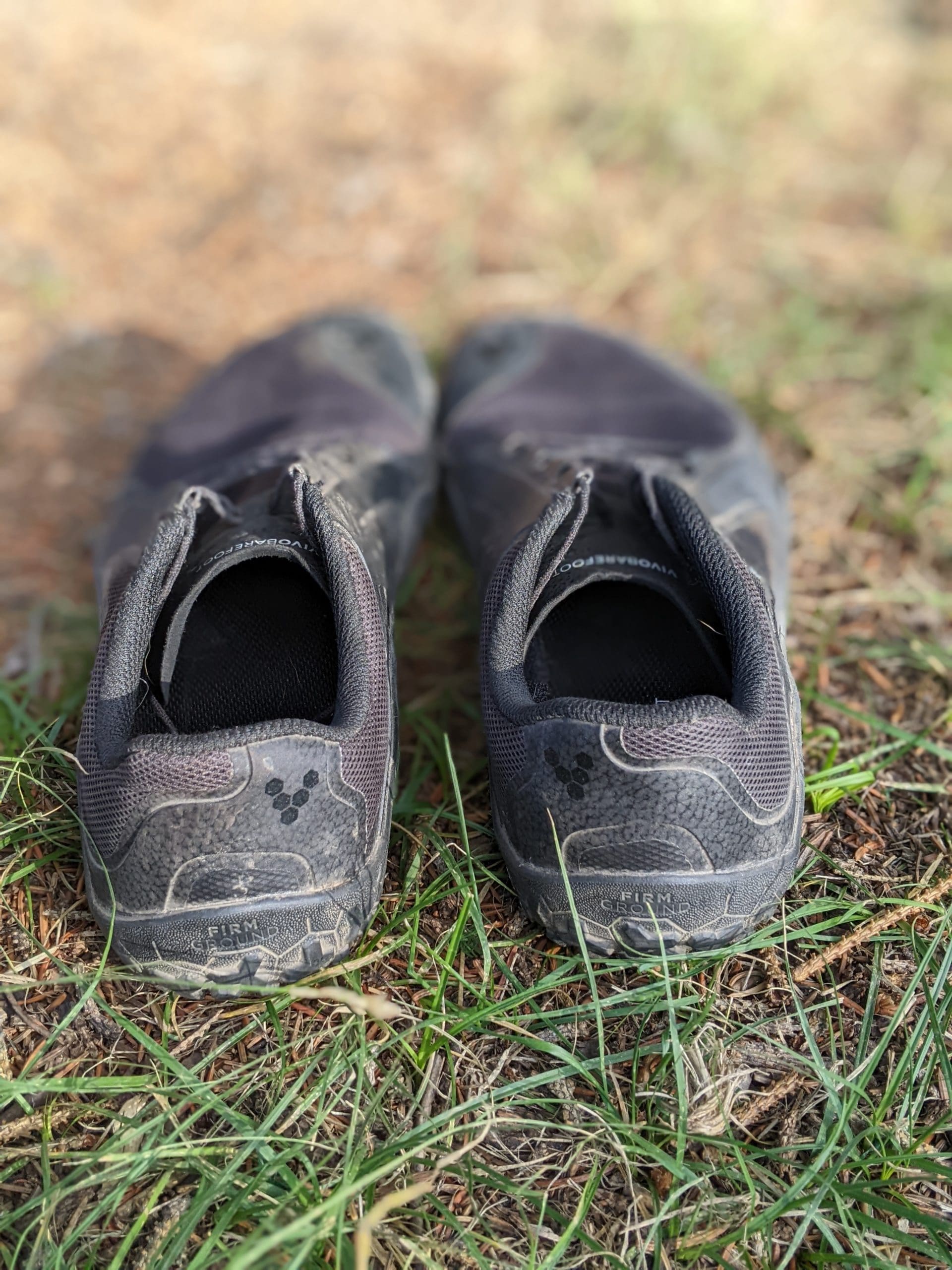
Heel
The heel is “well fitted,” and if it wraps around your foot well, it provides a great heel lock. But the Primus Trail Knit could be a better choice than the standard Primus Trail if you want a shoe with a wider ankle cuff and flexibility. I’ve never had any heel slippage issues and no blister concerns.
Midfoot
Insole in or out? It’s a personal preference. With the insole in, the Primus line is somewhat shallow. Personally, I have to remove the insole to gain a little more room in the toes and across the midfoot. The great thing about removing the insole (or leaving it in) is the options it presents. If I want a more comfortable run, I’d take the insole out. But I would consider putting the insoles back in for more technical terrain to achieve a more precise fit.
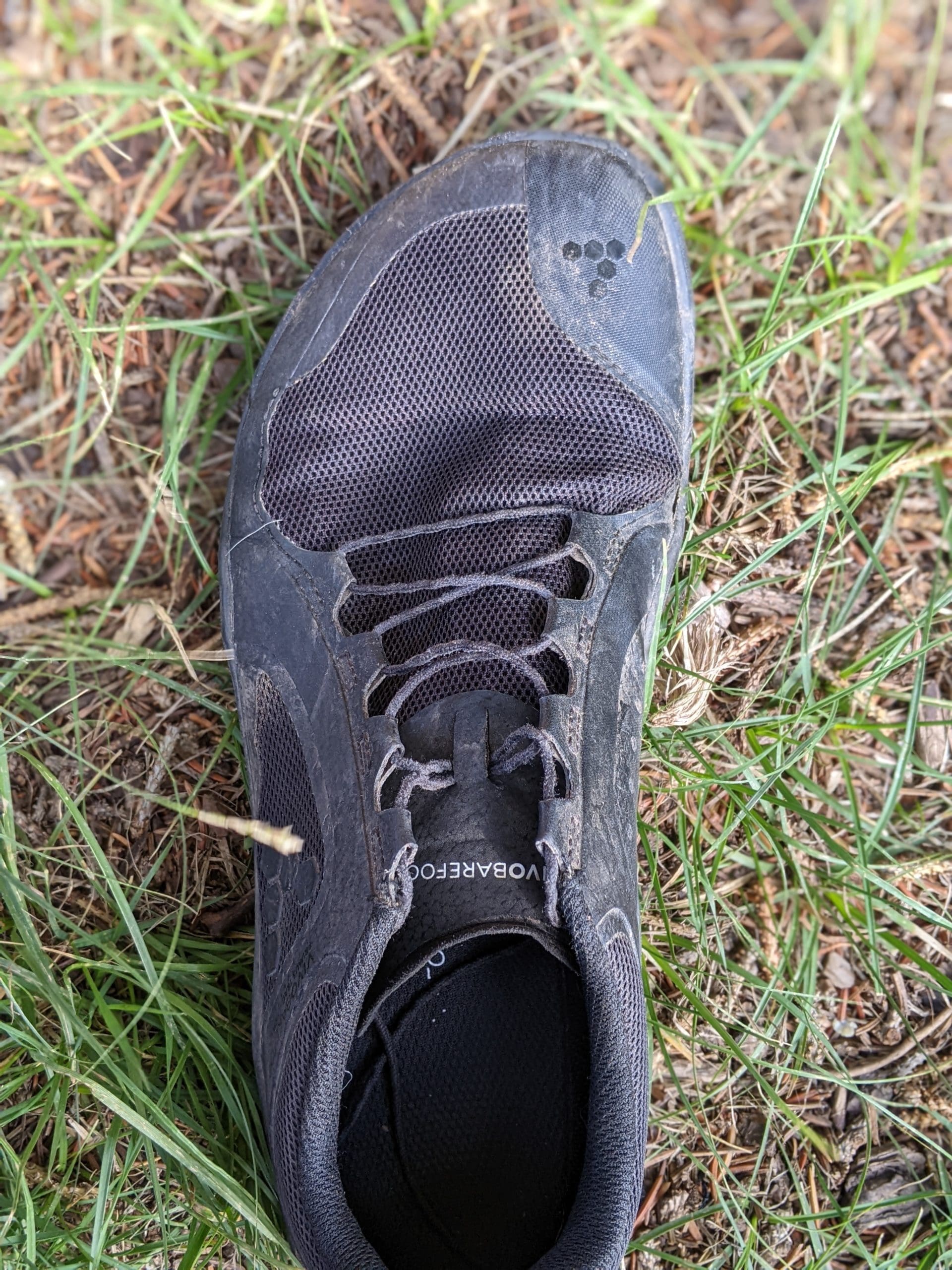
Lacing
Some will dislike the drawstring lacing system, but others will love the ability to slip these shoes on and off. I replaced the drawstring with some thin leather laces to gain a little more precision in fit. But I’m not convinced that was required or necessary..
Do not overtighten these shoes! The materials are stiff and very unforgiving if you overtighten them. Keep it snug –not tight. I’ve not had any issues slipping around in the shoe with this philosophy.
Which minimal running shoe is for you?
Take a quick 5-question quiz to identify the perfect minimal running shoe for your feet! You'll get both road and trail options based on your answers!
Arch
Some have noted the Primus trails can be uncomfortable on the arch. After running a bit more in these shoes, I put this feedback down to how the outsole wraps around the shoe, potentially pushing into the arch during the pronation stage –especially if the foot is too wide for the shoe. Those with “flat feet” will likely feel this more, so it’s worth considering.
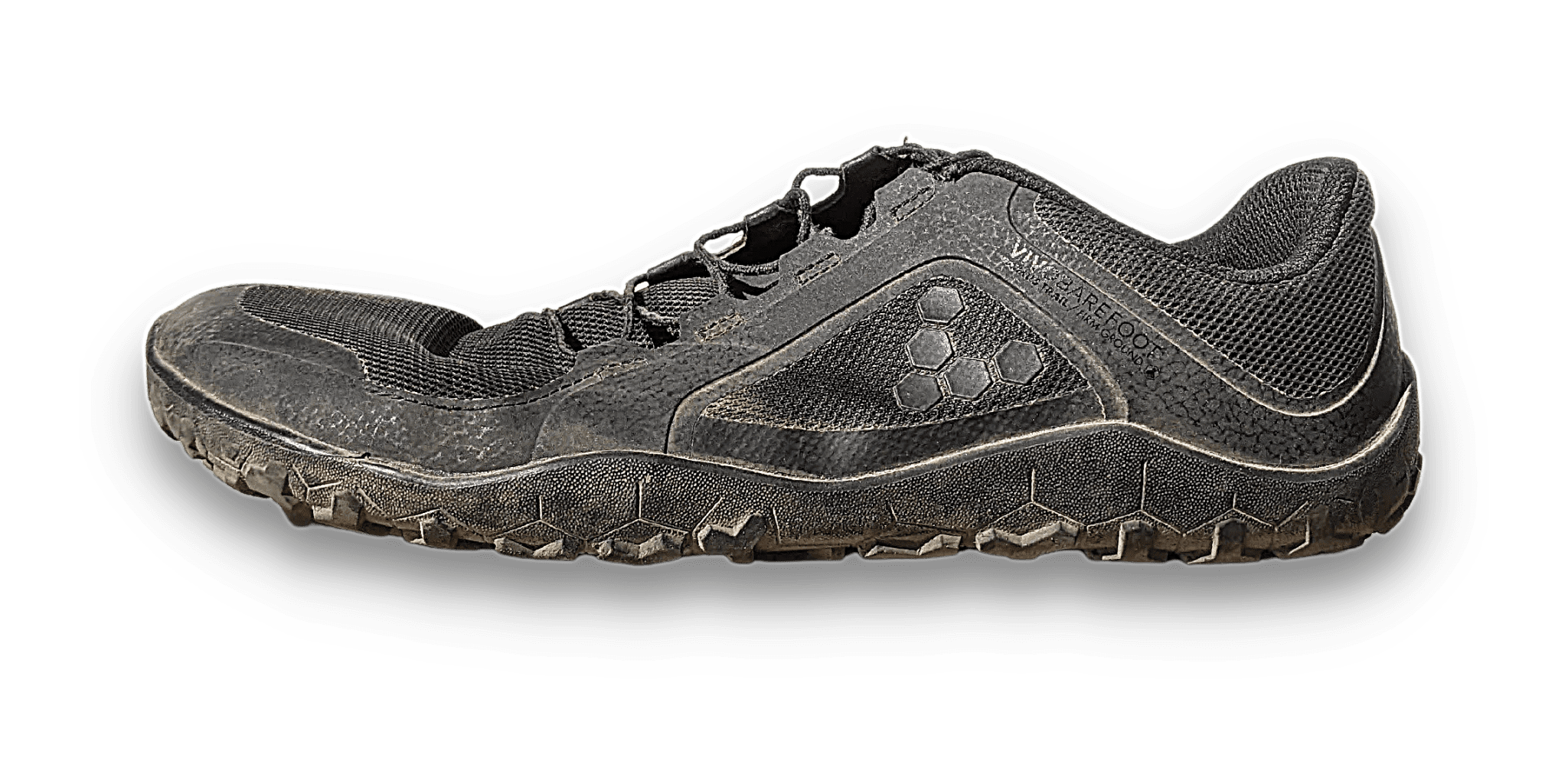
Vivobarefoot Primus Trail
They feel barefoot! Meaning, they’re close to the ground, with a 3mm base rubber and 2.5mm lugs –which also means they’re superbly flexible.
When it comes to the ground feel, I think they sit directly between the Xero Shoes Mesa Trail and the Xero Shoes Scrambler Low, so if you slam onto some sharp, pointy rocks, you’ll know about it, but your foot won’t get bruised up on rocky features if you’re mindful!
Flexibility
The shoe is more than flexible but favors certain flex points. In particular, there’s a crease in the forefoot area that is much more pliable than the surrounding areas. If that lands on your natural forefoot bend, then it’s all good. If it doesn’t….well. I’m not sure.
The shoe twists with the foot, allowing the foot to move naturally. While it doesn’t flex as much as my favorite Xero Shoes Mesa Trail II, it still does a good job, especially because it’s a ton more protective.
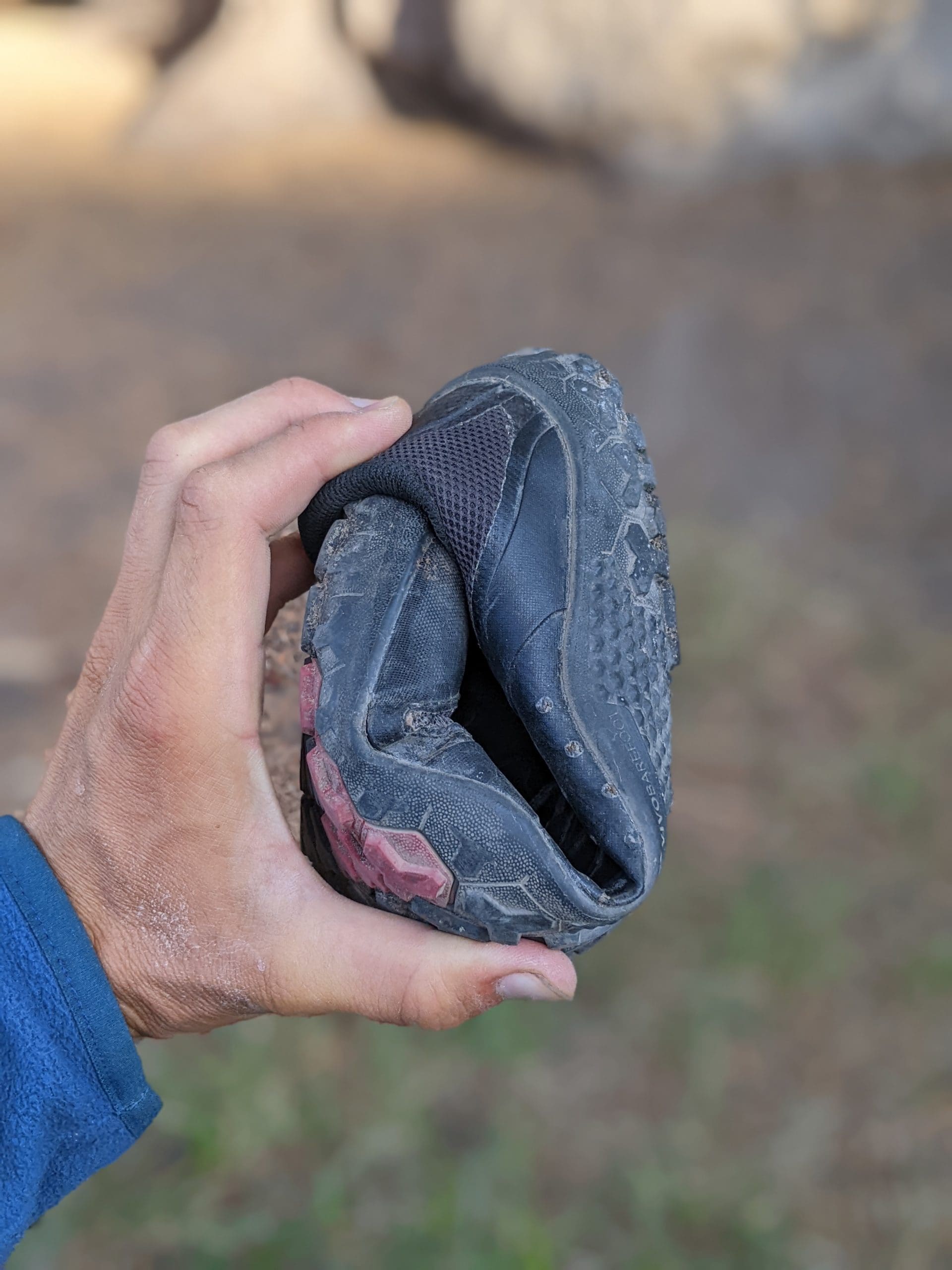
Ground feel
A 5.5mm outsole is pretty thin for the barefoot market and especially thin in the trail world. But Vivobarefoot states they use a 0.8mm Pro5 Puncture Resistant layer to reduce any sharp objects that cause issues. When I compare the feel against the Mesa Trail II, it’s plain to see that the Vivobarefoot has more protection. So those sharp rocks will cause less of an issue.
The more protective outsole reduces the ground feel a little, but that’s a trade-off you have to balance. It also depends on the trail you’ll be using the shoes on. The more rocky the trail, the more protective the shoe should be.
Overall, I’d say these shoes are fun! I feel super secure in the upper, and I’m confident in planting my foot and knowing it won’t slide around –and as long as you get the fit right, I think they could work for others.
Comfort
For supreme comfort, you want soft, stretchy, and flexible materials. The Primus Trail doesn’t have that, but for good reason. Trail shoes need to feel secure and have good lateral stability. When you’re jumping from rock to rock and putting great force through the side of the shoe, you want to ensure your foot doesn’t slip over the outsole. That’s why the Primus Trail uses stiffer, rubberized plastic-like materials.

Grip
These shoes are best suited to dry, firm ground. I have taken them into the wet and muddy conditions, but the results weren’t great. 2.5mm lugs are not deep enough to get any grip. So they may work for small cross-country efforts, but they’re better suited for the dryer conditions.
If you are looking for a mud shoe, try the Primus Trail SG (soft ground) version instead.

Vivobarefoot Primus Trail
The great thing about this review is I’ve now got 300km on my pair of Primus Trails, and they still look great! Like really good.
Upper materials
Because the upper materials are overbuilt to withstand the trail, they show no signs of wear. The toe box is fairly solid and protective, and the tougher material extends all the way up the side of the shoe to protect the foot from any rock abrasions.
The only weak point of the upper is the mesh over the forefoot and toes. Although saying that, the mesh is in an area that doesn’t see much wear or damage. Because of that, I don’t expect it to fail any time soon. I see no breakdown yet.
Outsole
As with most trail shoes, the outsole is the first area to show signs of wear. The amount of wear will depend on the trails you run and your wear pattern, but personally, with 300km on my pair, I can see about 0.5mm of wear on the lugs. That’s an amazing result.
I’ve seen no signs of complete delamination, which is true of some other companies. Sometimes, you may see the heel or the tip of the shoe start to unpeel. I’ve not seen this yet, and I’m not expecting it any time soon. But I have more to say on this, so keep reading.

Flexpoints
One common failure point of the Vivobarefoot shoe is the forefoot flex point. I mentioned this rigid flex point before, and it actually becomes a weak point in the shoe as time goes by. Because the shoe flexes in this position over and over again, it creates a weak point between the outsole and upper. Over time, that starts to unpeel and could cause a hole.
I’ve never seen this 100% fail on anyone, but I have known people to return their shoes early, as this happened within the first few months of purchasing the shoe.
I have seen some of this separation on my pair. But it’s only minor, and I’ll continue to run in them until they completely fail. I imagine the outsole tread will wear down faster than this separation happens.

Vivobarefoot Primus Trail
If you’ve read my reviews before, you might know that I like to perform a quick gait analysis of myself running in the shoes. I feel it gives another dimension to help you and me make better shoe-buying decisions.
To perform the analysis, I use University grade measurement pods to estimate ground reaction force, peak impact force, pronation angle/speed, and much more.
To gather the data, I ran on a relatively flat 0.5-mile trail, running the first half at a 5:15 min/km speed and the second half at 4:10 min/km.
As a comparison, I also performed the test with 3 other shoes. So these results will show data for:
- Vivobarefoot Primus Trail FG
- Xero Shoes TerraFlex II (highly protective minimal shoe)
- Xero Shoes Mesa Trail (More forgiving upper)
- Altra Superior 5 (21mm of cushion but still zero-drop)
Results
First up, we’re going to look at Impact forces. This is the force exerted in a vertical direction when my foot first contacts the ground.
Impact Forces
| Shoe | Vivobarefoot Primus Trail FG | Xero Shoes Mesa Trail | Xero Shoes TerraFlex II | Altra Superior 5 |
| Impact Force (G) | 3.2 | 7.6 | 5.1 | 6.2 |
The Vivobarefoot Primus Trail FG scored nearly half of any other shoe!
Now that’s strange because typically, shoes with less cushion usually cause a higher impact. Look at the Mesa Trail, for example.
These results have been repeated on longer runs too, where the impact force was 4.0.
Something about the shoe forces me to “feather” the ground and land softly. And that lines up well with the feeling of a truly minimal feel.
With these results, I’d be 100% confident recommending Primus Trail shoes to new barefoot runners.
I would expect they’d help teach a natural barefoot running gait and help strengthen key stabilizing areas.

Pronation
Pronation is the angle measurement of the ankle rolling in or out from the foot’s initial contact position.
Many hear about overpronation and expect that they need a well-structured shoe to “correct” pronation. In fact, some amount of pronation is expected and is an essential shock absorption mechanism.
There are two interesting data points of pronation. How far your ankle travels from side to side during a step, and how fast it happens.
| Shoe | Vivobarefoot Primus Trail FG | Xero Shoes Mesa Trail | Xero Shoes TerraFlex II | Altra Superior 5 |
| Pronation Angle (degrees) | -17.5 | -19.2 | -20.6 | -19.5 |
| Pronation Velocity(degrees/sec) | 1032 | 1014 | 1135 | 1068 |
The Vivobarefoot results in the least amount of pronation out of the test shoes, again likely due to the true barefoot feel.
I believe I receive much more sensory feedback from the ground, which is activating the stabilizing muscles to prevent “too much” pronation.
These results further back up what I mentioned previously. The Vivobarefoot Primus Trail FG is a great shoe for re-training your barefoot gait.
If you have normal to narrow feet and you don’t want to buy a lot of shoes, Vivobarefoot Primus Trail could be an excellent option.
With choices of FG (firm ground) and SG (soft ground), you can choose the option that best suits the trails you hit.
The securely fitted upper makes for a confident ride down the trails, and the flexible outsole helps build that barefoot gait.
And although the price point is a little high, the potential longevity of the shoe may balance this price out over the long term.
I will continue running in these shoes until they fail on me. And that could be years from now!

Vivobarefoot Primus Trail
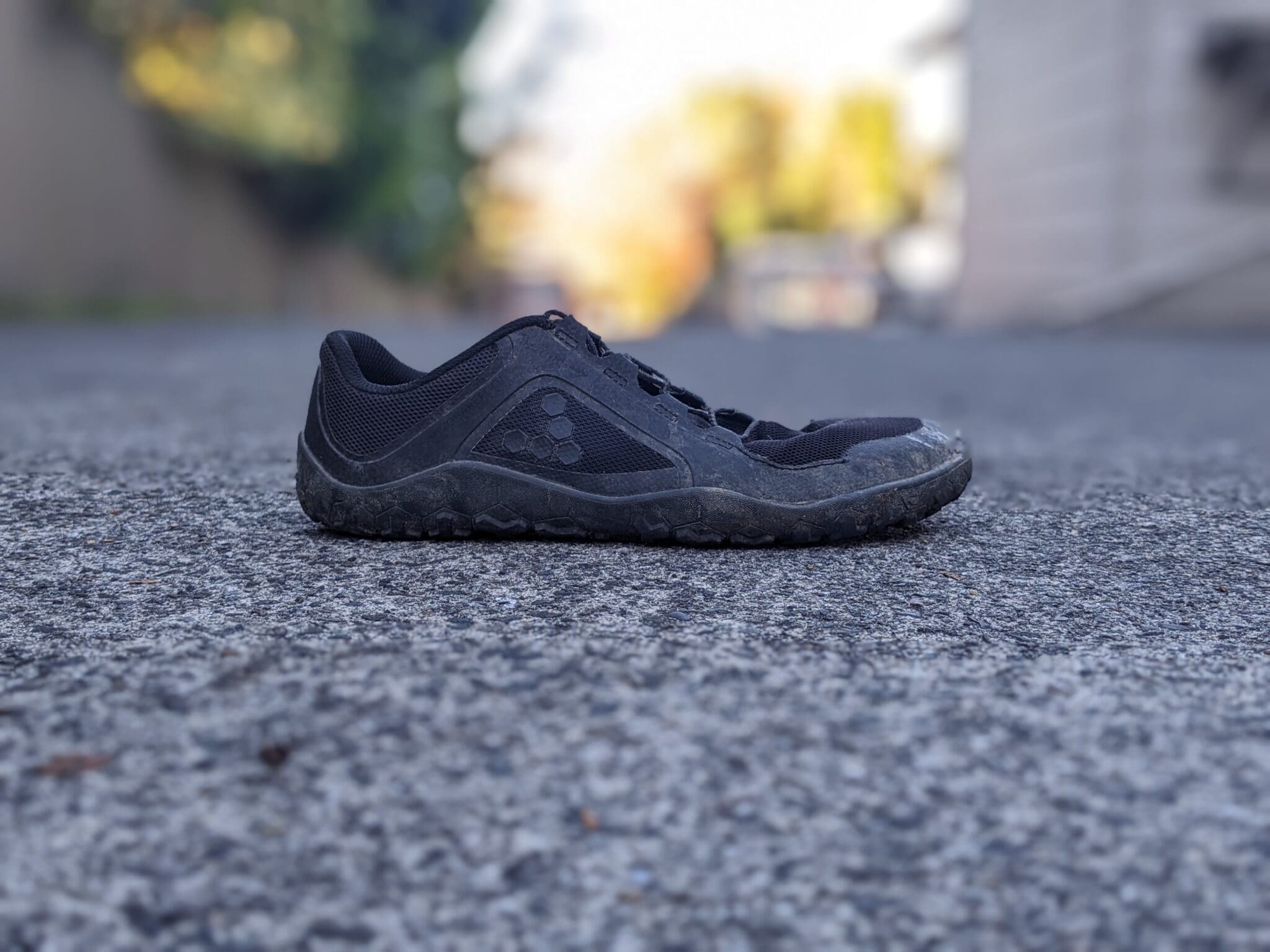
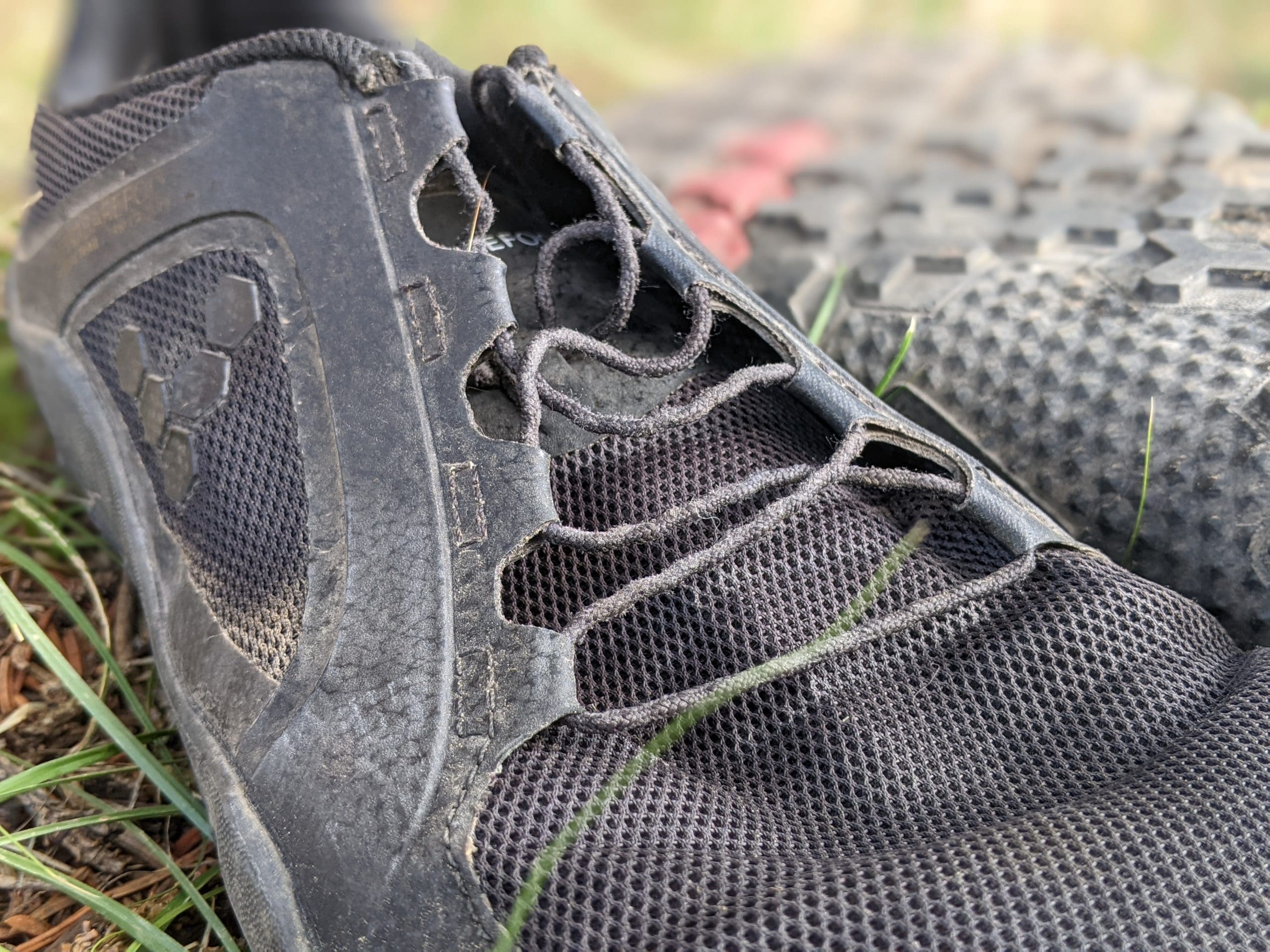
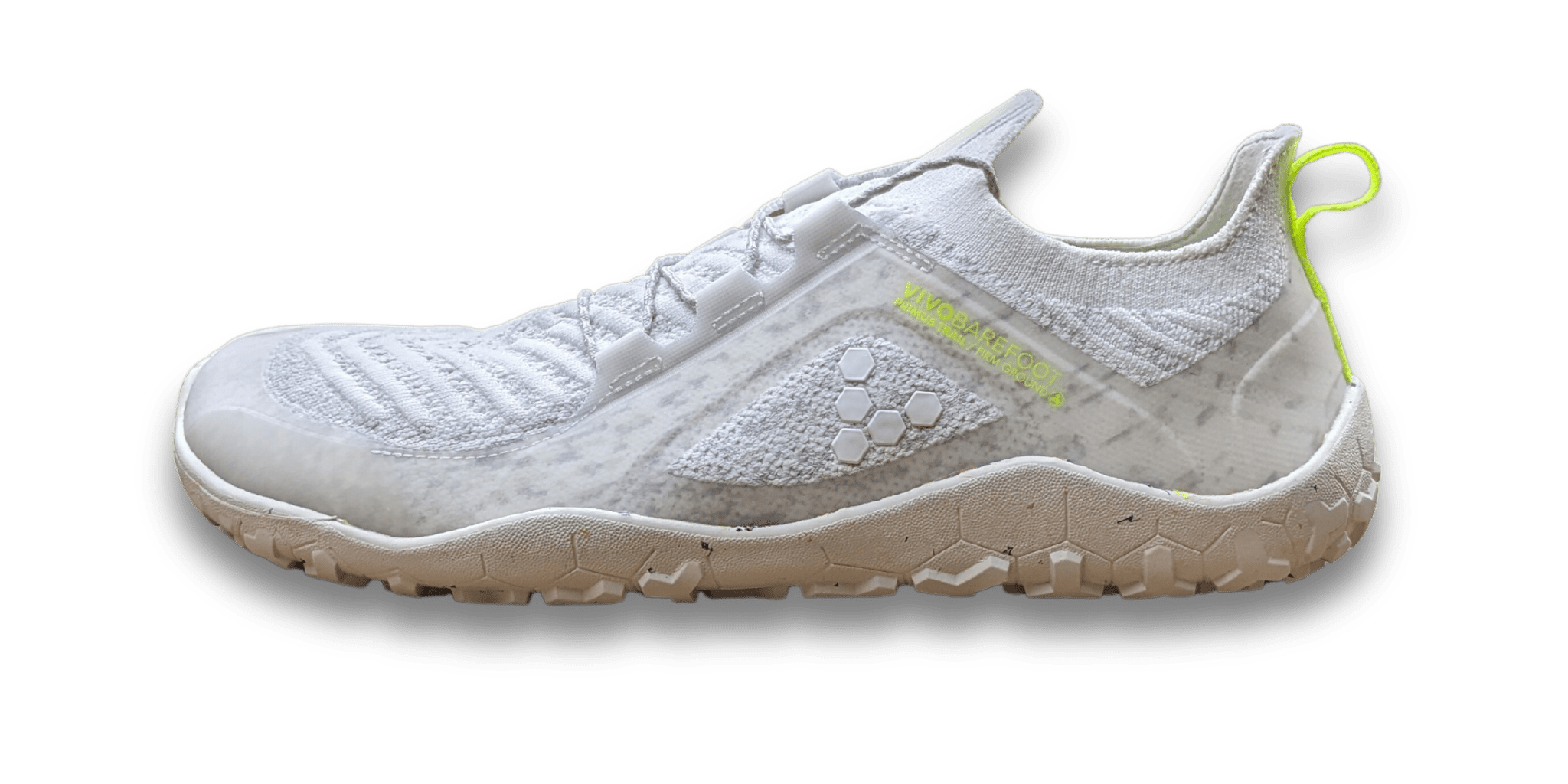


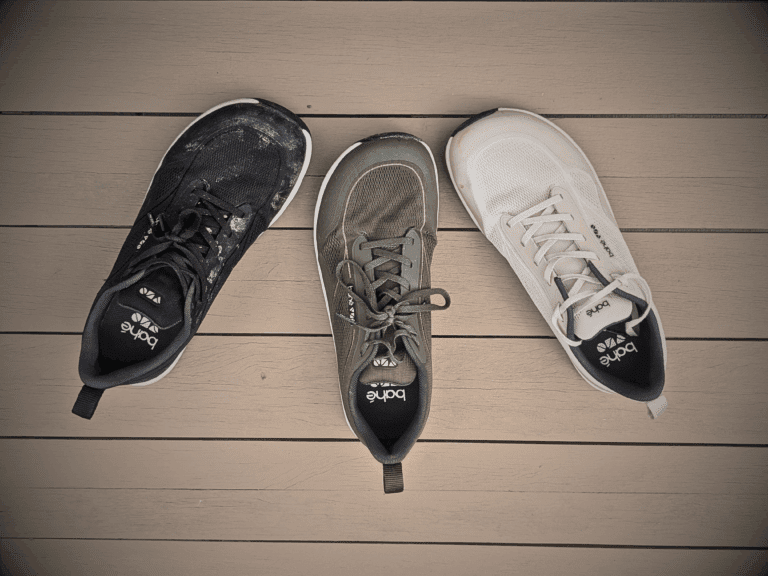

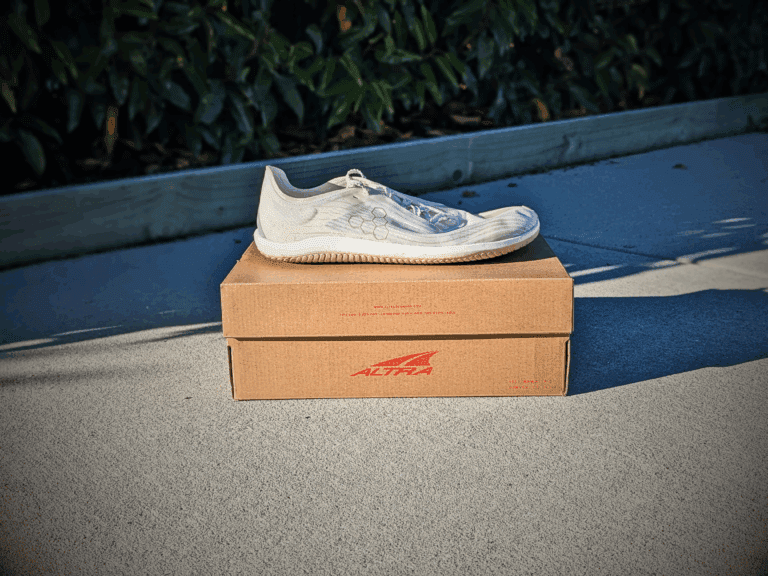
Hello. Great review. However, I have to disagree about Vivobarefoot shoes being for people with normal to narrow feet. I have wider than normal feet with fallen arches and Vivo, especially RAIII, Addis, and Primus Trail II FG, fit perfectly. Not all Vivo shoes are as wide and the Primus Lite III I found slightly narrower than the Trail II FG. Lems are what I find too narrow in the midfoot. After my feet started spreading out more, I could no longer wear them. The toe box on Lems is more rounded at the big toe, so you would have to size up to get the same feel as Vivo. For me, a vast difference between Vivo and Lems in that area. Vivo is more expensive, but I won’t buy anything else. Lems are well made, but far too narrow for my liking. Just wanted to point out my own experience with both shoes. Again, great review. Thanks!
I’m a little surprised, but you know, we all have different feet. As long as we find something we like, that’s the main part!
I’d agree with you on the Addis, but I’ve not had a chance to try RA iii. Do you feel they use the same last?
As for the primus pair, I feel they’re super similar, and I’ve managed to verify the fit with my wife’s narrow foot, and many on the BarefootRunning Reddit group. Many actually think they’re narrow! Which I don’t fully agree with, but I know what they’re getting at.
What I’m more interested in is your opinion on Lems. Which models have you tried? I can see how the toe box is a little more rounded than some, although it usually means 1/2 larger will fix that, but I’ve not felt narrowness in the midfoot before. I’m interested which models you felt this in.
Thanks for the feedback; it’s always interesting to hear other experiences!
Hello Nick. Sorry for the late reply. I can see why some would say Vivos are narrow when looking at the inside, but they don’t feel narrow when wearing (and definitely don’t look it from the bottom). Something about the way they are constructed (maybe lower to the ground) gives them a more solid feel.
The Addis are made in Ethiopia, while the RA are made in Portugal. The RA feel better constructed, but are more expensive as well. Though I prefer the Addis because they are slightly wider, more stable in a way. I have both the regular version and the Oxford. Fantastic shoes.
As for Lems, I still have the Boulder Boot WP and the Vegan Mid-Boot. They are not as narrow (or clunky) as the Nine2Five (which I trashed) Yes, you can size up but then they would be too loose. They are also not aesthetically pleasing as the toe box is very bulbous and then narrows in. The Nine2Five were shaped like a lightbulb and two different colleagues commented at the odd appearance. The boots are better, but only just. They have a thicker base coupled with the narrow midfoot give them a less stable feel for me. I can wear them but prefer not to. I won’t be replacing them. My daugher is 10 years old and a bit of a fashionista. She loves my Vivos and wants a pair of her own. However, she hates the Lems. She says they look lazy.
I currently own the previously mentioned RAIII and two Addis variants, along with the Primus Trail II FG, and the new Motus. I would replace all them with the same shoe. Great stuff.
Hey Nick – I have been rotating pairs of Primus Trail FG I ie the original model from 3 years ago. They have finally given up and I ordered a pair of the FG II from Vivo. The internal space seems greater and the footbed seems flat and not at all shaped. In short, they are not workable – have you any experience along these lines?
That’s disappointing to hear. But let’s dig in to find out why.
When you say the “internal space is greater”, could you elaborate? i.e. is the shoe shorter? Less width in the forefoot or the midfoot, or is it deeper, meaning you cannot get a lockdown?
As for the footbed, when you say it’s “flat”, is that because you used to feel some arch support?
Sadly, I’ve never had a chance to try the original Primus Trail, so I can’t help with comparing the new to the old. I tried to do a little research to see the differences from old reviews, but I see very little differences.
Let’s first rule out sizing issues, and if nothing is working, I could assess which model you should look at from your foot type.
Thanks!
Hi All great review and comments. I’m getting ready to purchase a pair of vivo and I normally wear 10.5 in adidas or merrel. What size do you recommend I purchase as the foot size guide paper says I should be in a 12!?? I was thinking of ordering the 11 and returning if needed.
That sizing seems strange. For me these shoes fit true to size, so I expect there’s a mistake somewhere along the line. Just make sure you’re comparing US -> US sizing, or UK -> UK.
You can also use the StrutFit system on Vivobarefoot which allows you to take a photo of your foot, and it’ll tell you the size you should opt for. You will find it under the size selection on the Vivobarefoot website (https://www.vivobarefoot.com/uk/primus-trail-iii-all-weather-fg-mens).
Thank you for your very in depth review. Is it just me or when I take out the insert in my Vivo trail my feet start to sweat a lot? I have had some issues with the side foot callous due to that rubber raised lip on the side of the shoe. I have an order for the Primus Lite III and seeing if that will help since they don’t have that lip. They do suggest taking out the insert but had sweaty feet problems. Thank you.
I’m not sure about the sweaty feet part. I’ve not experienced it, but in general, the shoe isn’t very breathable.
But they’re right about the outsole not wrapping up as high around the foot. So you may find that get’s solved.
Thank you for your kind reply. Yes teh Primus Lite III is better without teh wraparound high rubber part. The primus lite are a bit longer which is good but a bit snug w teh inserts so I took them out. Will see how it goes. They are well made and look good. Just hope the sweaty feet is not an issue. Thanks again.